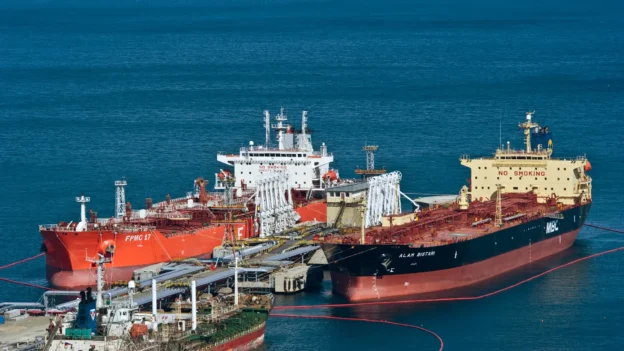Table of Contents
The XXI Conference of Oil Maritime Terminals and Single Buoy Mooring Operators (SLOM 2025) is being held in Panama. More than just a technological showcase, this event is a space for reflection on the future of the oil maritime industry in Latin America. Today, everything is moving toward automation, energy efficiency, and digitalization. SLOM 2025 proposes an integrated perspective: yes to technology, but with the human factor at the center.
The Chiriquí Lagoon, the Panama Canal, and the region’s terminals become living laboratories where innovation, sustainability, and organizational culture converge. These local and international experiences highlight the key innovations shaping the event, from advanced mooring systems to computational simulations, while always keeping in mind the people who make each operation possible.
MBM: Multiple Mooring for Deep-Draft Vessels
The arrival of VLCC (Very Large Crude Carriers) and SUEZMAX vessels to Chiriquí Lagoon has demanded stronger and more versatile mooring solutions. The Multiple Buoy Mooring (MBM) system now being implemented at SPMB NORTE represents a significant step forward in operational safety and efficiency.
This system distributes mooring stresses across several points, reducing the risk of structural failures and making maneuvers easier in adverse weather. For example, during a rainy-season night operation, the MBM kept a 300,000-ton VLCC stable, preventing dangerous drift that could have compromised both the buoy and the vessel. Besides improving safety, MBM also optimizes unloading times, lowering operational costs.
BAS: Smart Berthing
Another key player is entering the fray. It is one of the innovations in this sector that is becoming increasingly established because it is a system that combines laser sensors, thermal cameras, and predictive algorithms to monitor the speed, angle, and distance of ships during docking in real time. In its 4.0 version, the Berthing Aid System (BAS) integrates with port management systems and simulation platforms, anticipating risk scenarios and facilitating informed decisions.
Let’s imagine a situation in which a tanker is approaching in crosswinds. In this case, the BAS detects the deviation and alerts the operator to correct the maneuver before an impact occurs. This ability to anticipate makes the BAS an undeniable strategic ally for operational safety.
Computational simulation: Sailing before casting off
Computational simulation has shifted from being an academic tool to an essential part of port planning. In oil maritime terminals and SBM buoys, digital models recreate tides, waves, loading/unloading, and ship-structure interactions.
One key example: simulators now train operators for emergency maneuvers. In a virtual environment, they can practice responses to mooring line breaks, pump failures, or loss of propulsion, strengthening safety culture without risking lives or assets.
Cross Docking and ship-to-ship transfers
Cross Docking operations and Ship-to-Ship (STS) transfers have always been a highly complex logistical challenge. They require meticulous coordination between schedules, storage capacities, product compatibility, and sea conditions. SLOM 2025 will present success stories where these operations have reduced transit times and maximized fleet utilization.
For example, in a recent operation in the Pacific off Panama, crude oil was transferred between two ships in less than six hours, thanks to simulation-based planning and real-time monitoring. This type of efficiency is key in a market where every minute counts.
Energy Management: The OCP terminal case
Energy sustainability is another focus of the event. Sustainability is increasingly being discussed, and the best approaches to achieving this goal are being implemented. The Energy Management System at the OCP (Heavy Crude Oil Pipeline) Maritime Terminal in Ecuador will be presented as a model of efficiency. This system integrates renewable sources, consumption monitoring, process automation, and data analysis to reduce the carbon footprint of port operations.
In figures: thanks to the implementation of this system, the terminal has managed to reduce its annual energy consumption by 18% without affecting productivity. This type of innovation demonstrates that profitability and sustainability can go hand in hand.
CALM Buoy: Technology renewal
The replacement of the Product Transfer Unit on SBM Offshore’s CALM (Catenary Anchor Leg Mooring) buoy is a critical operation that will be discussed in depth. This unit, which enables the transfer of hydrocarbons between ships and floating terminals, must be replaced periodically to ensure its integrity.
The process involves precision engineering, logistical coordination, and strict compliance with environmental regulations. In a recent operation in the Caribbean, the replacement was completed in less than 72 hours, minimizing the impact on the supply chain. These types of interventions are essential to maintaining operational continuity and environmental safety.
The human factor
The human factor is recognized as the true driving force behind the industry. From crane operators to engineers who design systems, each individual contributes knowledge, experience, and judgment; but the strongest root of this factor is also manifested in a sense of belonging.
Talent management, continuous training, and workplace well-being are central issues. Likewise, strengthening soft skills, providing incentives to foster leadership, and preventing professional burnout. In a high-pressure environment, taking care of the team is as important as maintaining the technical equipment.
Safety culture: BRIO and risk factor
Finally, the BRIO program (Good Practices, Responsibility, Integrity, and Organization) and the Risk Factor tool will be presented as pillars of the safety culture. BRIO promotes safe behavior, effective communication, and shared responsibility. Risk Factor, meanwhile, allows risks to be identified and mitigated before they materialize. At a terminal on the Colombian Atlantic coast, the implementation of BRIO reduced workplace incidents by 40% in one year. SLOM 2025 is an invitation to rethink the future of maritime oil terminals from a comprehensive perspective.
Conclusion
Maritime innovations are proof that the industry is moving toward greater efficiency, safety, and sustainability in the face of challenges such as offshore oil spills. The evolution of satellite technologies in the maritime industry now offers innovative solutions for oil spill detection and maritime transport, providing speed, accuracy, and predictive capabilities in emergency management and ship location. But the real message of the event is that, amid so much technology, human beings remain irreplaceable.
For more content on SLOM 2025, visit our coverage on Inspenet.
Reference
Own source

